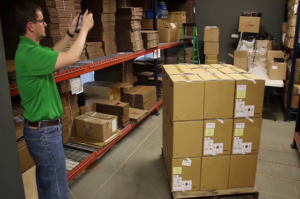Five Key Issues Emerge During Arnall Golden Gregory’s Interviews at the 2017 Georgia Logistics

Approximately 1,200 people attended the 9th Georgia Logistics Summit, which was held May 16-17 at the Georgia World Congress Center. Arnall Golden Gregory has been a summit sponsor since 2013.
Michael D. Golden, co-leader of AGG’s Logistics and Transportation Practice, with 18 attorneys, serves on the Georgia Logistics Summit Executive Committee. This year’s keynote speaker was Sandra MacQuillan, Chief Supply Officer at Kimberly-Clark, who was introduced by AGG partner Ashley Steiner Kelly. Another partner, Andrew J. Schutt, moderated the panel discussion “New & Next Statewide,” about economic development trends.
AGG contracted with former television journalist Laurie Dhue to interview summit attendees at the firm’s booth, which generated considerable buzz at the event. Two dozen business professionals shared their insights. Here are five themes that emerged from those discussions.
1.Technology is Playing a Bigger Role in the Industry
Disruptive technology was perhaps the most popular topic at this year’s summit. A new feature was the Logistics Technology Showcase, where companies displayed their innovative products. One of the early summit sessions, “Logistics Technology Disruptors,” drew a large audience, and a later session focused on transportation technology. Technology frequently came up in AGG’s interviews with two dozen summit attendees. They talked about electronic data interchange between logistics companies and their business partners; electronic payments for trucking, freight handling and logistics; technology that predicts the likelihood of parts failures; robotics in distributions centers; wearable technology for warehouse workers; and event data recorders in trucks. Other innovations in the pipeline include drone deliveries and autonomous vehicles.
2.Attracting Qualified Millennial Workers is a Challenge
Bringing qualified young people into the industry is a longstanding problem. Attendees told AGG the industry has an image problem that hurts recruitment. Many millennials view logistics and transportation jobs as dead-end work, when, in fact, it has become much more technology focused. One executive said trucking companies need to be more honest about the rigors of the job and shift from cross-country trips to regional trips to improve the work-life balance for drivers. Another business leader said allowing drivers to make interstate trips at a younger age would help with hiring. Puga Sankara, principal of Smart Gladiator, told AGG that promoting technology that millennials are comfortable using, such as smart-phone apps, will make warehouse work more attractive. Millennials also like the Results Only Work Environment (ROWE), in which employees are paid according to results rather than time spent at the workplace, explained Enrique Alvarez, managing director at Vector Global Logistics.
3. E-commerce is Driving Changes
As more consumers buy online, the expectation is that fulfillment centers will process orders immediately, allowing in some cases same-day delivery. The demand for quick turnaround is influencing investment and hiring decisions. Seasonal warehouse workers increasingly are important, but how do you hire enough of them and get them up to speed quickly? One enticement is wearable technology that young people, in particular, are comfortable using. Wearable technology allows free use of the hands and eliminates the need to walk long distances, thus reducing fulfillment time. E-commerce also is spurring warehouse automation. Warehouses are being built higher to fit tall robotics equipment. Urban warehouses with smaller footprints will become more commonplace to quickly fill orders.
4. It’s Easy to Run Afoul of the Myriad Regulations
Approximately 48 government agencies regulate trade, according to Donna Mullins of Mullins International, a compliance training firm. Of particular concern for companies involved in global trade is U.S. Customs and Border Protection’s Trade Facilitation and Enforcement Act, which Mullins called “the iron hammer” in her interview with AGG. Another recent development is the Automated Commercial Environment (ACE) system, the portal through which businesses provide data to several government agencies. Businesses have had to adjust their supply chain processes to comply with ACE requirements. At last year’s summit, a panel discussion moderated by AGG partner Michael E. Burke addressed “the upcoming regulatory tidal wave.” The panelists discussed the challenges businesses face because of amendments to the Safety of Life at Sea (SOLAS) Convention and the Food Safety Modernization Act.
5. With Boomers Retiring, Consolidation is Continuing
Whether it’s the founder’s plan to retire or a small business’s desire to remain competitive in an increasingly complex industry, M&A activity in the logistics and transportation space is ongoing. Customers are demanding “one-stop shop,” integrated services, which businesses without proper scale cannot provide. Matt Clark, chief financial officer at CFO Advisors, said in his AGG interview that baby boomers who founded their trucking businesses decades ago when trucking was deregulated now want to sell if family members have no interest in taking the reins. At the same time, the founder wants to protect jobs, which might be difficult if the prospective buyer is a private equity fund looking to make the business leaner in order to sell it later. PWC forecasts strong consolidation activity in trucking and shipping in 2017. Globalization, e-commerce and disruptive technology also are driving investments in companies.
Click here to know more.








